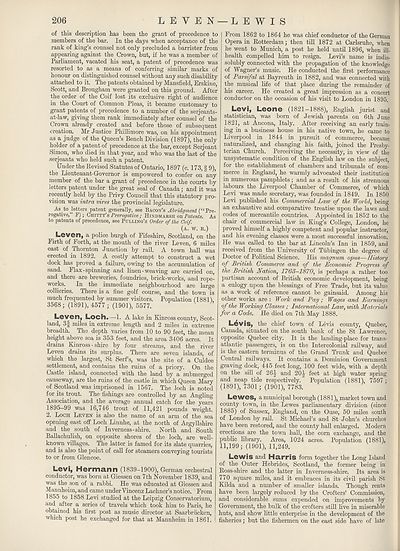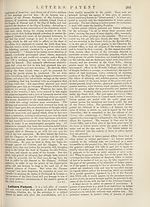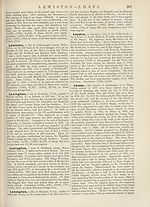New volumes of the Encyclopædia Britannica > Volume 30, K-MOR
(234) Page 206
Download files
Complete book:
Individual page:
Thumbnail gallery: Grid view | List view

206
L E V E N-
of this description has been the grant of precedence to
members of the bar. In the days when acceptance of the
rank of king’s counsel not only precluded a barrister from
appearing against the Crown, but, if he was a member of
Parliament, vacated his seat, a patent of precedence was
resorted to as a means of conferring similar marks of
honour on distinguished counsel without any such disability
attached to it. The patents obtained by Mansfield, Erskine,
Scott, and Brougham were granted on this ground. After
the order of the Coif lost its exclusive right of audience
in the Court of Common Pleas, it became customary to
grant patents of precedence to a number of the serjeants-
at-law, giving them rank immediately after counsel of the
Crown already created and before those of subsequent
creation. Mr Justice Phillimore was, on his appointment
as a judge of the Queen’s Bench Division (1897), the only
holder of a patent of precedence at the bar, except Serjeant
Simon, who died in that year, and who was the last of the
serjeants who held such a patent.
Under the Revised Statutes of Ontario, 1897 (c. 173, § 9),
the Lieutenant-Governor is empowered to confer on any
member of the bar a grant of precedence in the courts by
letters patent under the great seal of Canada; and it was
recently held by the Privy Council that this statutory pro¬
vision was mtra vires the provincial legislature.
As to letters patent generally, see Bacon’s Ahridgment (1 ‘ Pre¬
rogative,” F) ; Chitty’s Prerogative; Hindmarsh on Patents. As
to patents of precedence, see Pulling’s Order of the Coif.
(a. w. r.)
_ Leven, a police burgh of Fifeshire, Scotland, on the
Firth of Forth, at the mouth of the river Leven, 6 miles
east of Thornton Junction by rail. A town hall was
erected in 1892. A costly attempt to construct a wet
dock has proved a failure, owing to the accumulation of
sand. Flax-spinning and linen-weaving are carried on,
and there are breweries, foundries, brick-works, and rope-
works. In the immediate neighbourhood are large
collieries. There is a fine golf course, and the town is
much frequented by summer visitors. Population (1881),
3568 ; (1891), 4577 ; (1901), 5577.
Levers, Loch.—1. A lake in Kinross county, Scot¬
land, 3f miles in extreme length and 2 miles in extreme
breadth. The depth varies from 10 to 90 feet, the mean
height above sea is 353 feet, and the area 3406 acres. It
drains Kinross-shire by four streams, and the river
Leven drains its surplus. There are seven islands, of
which the largest, St Serf’s, was the site of a Culdee
settlement, and contains the ruins of a priory. On the
Castle island, connected with the land by a submerged
causeway, are the ruins of the castle in which Queen Mary
of Scotland was imprisoned in 1567. The loch is noted
for its trout. The fishings are controlled by an Angling
Association, and the average annual catch for the years
1895-99 was 16,746 trout of 11,421 pounds weight.
2. Loch Leven is also the name of an arm of the sea
opening east off Loch Linnhe, at the north of Argyllshire
and the south of Inverness-shire. North and South
Ballachulish, on opposite shores of the loch, are well-
known villages. The latter is famed for its slate quarries,
and is also the point of call for steamers conveying tourists
to or from Glencoe.
Levi, Hermann (1839-1900), German orchestral
conductor, was born at Giessen on 7th November 1839, and
was the son of a rabbi. He was educated at Giessen and
Mannheim, and came under Yincenz Lachner’s notice. From
1855 to 1858 Levi studied at the Leipzig Conservatorium,
and after a series of travels which took him to Paris, he
obtained his first post as music director at Saarbriicken,
which post he exchanged for that at Mannheim in 1861. !
-LEWIS
From 1862 to 1864 he was chief conductor of the German
Opera in Rotterdam; then till 1872 at Carlsruhe, when
he went to Munich, a post he held until 1896, when ill-
health compelled him to resign. Levi’s name is indis¬
solubly connected with the propagation of the knowledge
of Wagner’s music. He conducted the first performance
of Parsifal at Bayreuth in 1882, and was connected with
the musical life of that place during the remainder of
his career. He created a great impression as a concert
conductor on the occasion of his visit to London in 1895.
Levi, Leon© (1821-1888), English jurist and
statistician, was born of Jewish parents on 6th June
1821, at Ancona, Italy. After receiving an early train¬
ing in a business house in his native town, he came to
Liverpool in 1844 in pursuit of commerce, became
naturalized, and changing his faith, joined the Presby¬
terian Church. Perceiving the necessity, in view of the
unsystematic condition of the English law on the subject,
for the establishment of chambers and tribunals of com¬
merce in England, he warmly advocated their institution
in numerous pamphlets; and as a result of his strenuous
labours the Liverpool Chamber of Commerce, of which
Levi was made secretary, was founded in 1849. In 1850
Levi published his Commercial Law of the World, being
an exhaustive and comparative treatise upon the laws and
codes of mercantile countries. Appointed in 1852 to the
chair of commercial law in King’s College, London, he
proved himself a highly competent and popular instructor,
and his evening classes were a most successful innovation.
He was called to the bar at Lincoln’s Inn in 1859, and
received from the University of Tubingen the degree of
Doctor of Political Science. His magnum opus—History
of British Commerce and of the Economic Progress of
the British Nation, 1763-1870, is perhaps a rather too
partisan account of British economic development, being
a eulogy upon the blessings of Free Trade, but its value
as a work of reference cannot be gainsaid. Among his
other works are : Work and Pay ; Wages and Earnings
of the Working Classes ; International Law, with Materials
for a Code. He died on 7th May 1888.
L6vis, the chief town of Levis county, Quebec,
Canada, situated on the south bank of the St Lawrence,
opposite Quebec city. It is the landing-place for trans¬
atlantic passengers, is on the Intercolonial railway, and
is the eastern terminus of the Grand Trunk and Quebec
Central railways. It contains a Dominion Government
graving dock, 445 feet long, 100 feet wide, with a depth
on the sill of 26| and 20|- feet at high water spring
and neap tide respectively. Population (1881), 7597 :
(1891), 7301 ; (1901), 7783.
Lewes, a municipal borough (1881), market town and
county town, in the Lewes parliamentary division (since
1885) of Sussex, England, on the Ouse, 50 miles south
of London by rail. St Michael’s and St John’s churches
have been restored, and the county hall enlarged. Modern
erections are the town hall, the corn exchange, and the
public library. Area, 1024 acres. Population (1881),
11,199; (1901), 11,249.
Lewis and Harris form together the Long Island
of the Outer Hebrides, Scotland, the former being in
Ross-shire and the latter in Inverness-shire. Its area is
770 square miles, and it embraces in its civil parish St
Kilda and a number of smaller islands. Though rents
have been largely reduced by the Crofters’ Commission,
and considerable sums expended on improvements by
Government, the bulk of the crofters still live in miserable
huts, and show little enterprise in the development of the
fisheries; but the fishermen on the east side have of late
L E V E N-
of this description has been the grant of precedence to
members of the bar. In the days when acceptance of the
rank of king’s counsel not only precluded a barrister from
appearing against the Crown, but, if he was a member of
Parliament, vacated his seat, a patent of precedence was
resorted to as a means of conferring similar marks of
honour on distinguished counsel without any such disability
attached to it. The patents obtained by Mansfield, Erskine,
Scott, and Brougham were granted on this ground. After
the order of the Coif lost its exclusive right of audience
in the Court of Common Pleas, it became customary to
grant patents of precedence to a number of the serjeants-
at-law, giving them rank immediately after counsel of the
Crown already created and before those of subsequent
creation. Mr Justice Phillimore was, on his appointment
as a judge of the Queen’s Bench Division (1897), the only
holder of a patent of precedence at the bar, except Serjeant
Simon, who died in that year, and who was the last of the
serjeants who held such a patent.
Under the Revised Statutes of Ontario, 1897 (c. 173, § 9),
the Lieutenant-Governor is empowered to confer on any
member of the bar a grant of precedence in the courts by
letters patent under the great seal of Canada; and it was
recently held by the Privy Council that this statutory pro¬
vision was mtra vires the provincial legislature.
As to letters patent generally, see Bacon’s Ahridgment (1 ‘ Pre¬
rogative,” F) ; Chitty’s Prerogative; Hindmarsh on Patents. As
to patents of precedence, see Pulling’s Order of the Coif.
(a. w. r.)
_ Leven, a police burgh of Fifeshire, Scotland, on the
Firth of Forth, at the mouth of the river Leven, 6 miles
east of Thornton Junction by rail. A town hall was
erected in 1892. A costly attempt to construct a wet
dock has proved a failure, owing to the accumulation of
sand. Flax-spinning and linen-weaving are carried on,
and there are breweries, foundries, brick-works, and rope-
works. In the immediate neighbourhood are large
collieries. There is a fine golf course, and the town is
much frequented by summer visitors. Population (1881),
3568 ; (1891), 4577 ; (1901), 5577.
Levers, Loch.—1. A lake in Kinross county, Scot¬
land, 3f miles in extreme length and 2 miles in extreme
breadth. The depth varies from 10 to 90 feet, the mean
height above sea is 353 feet, and the area 3406 acres. It
drains Kinross-shire by four streams, and the river
Leven drains its surplus. There are seven islands, of
which the largest, St Serf’s, was the site of a Culdee
settlement, and contains the ruins of a priory. On the
Castle island, connected with the land by a submerged
causeway, are the ruins of the castle in which Queen Mary
of Scotland was imprisoned in 1567. The loch is noted
for its trout. The fishings are controlled by an Angling
Association, and the average annual catch for the years
1895-99 was 16,746 trout of 11,421 pounds weight.
2. Loch Leven is also the name of an arm of the sea
opening east off Loch Linnhe, at the north of Argyllshire
and the south of Inverness-shire. North and South
Ballachulish, on opposite shores of the loch, are well-
known villages. The latter is famed for its slate quarries,
and is also the point of call for steamers conveying tourists
to or from Glencoe.
Levi, Hermann (1839-1900), German orchestral
conductor, was born at Giessen on 7th November 1839, and
was the son of a rabbi. He was educated at Giessen and
Mannheim, and came under Yincenz Lachner’s notice. From
1855 to 1858 Levi studied at the Leipzig Conservatorium,
and after a series of travels which took him to Paris, he
obtained his first post as music director at Saarbriicken,
which post he exchanged for that at Mannheim in 1861. !
-LEWIS
From 1862 to 1864 he was chief conductor of the German
Opera in Rotterdam; then till 1872 at Carlsruhe, when
he went to Munich, a post he held until 1896, when ill-
health compelled him to resign. Levi’s name is indis¬
solubly connected with the propagation of the knowledge
of Wagner’s music. He conducted the first performance
of Parsifal at Bayreuth in 1882, and was connected with
the musical life of that place during the remainder of
his career. He created a great impression as a concert
conductor on the occasion of his visit to London in 1895.
Levi, Leon© (1821-1888), English jurist and
statistician, was born of Jewish parents on 6th June
1821, at Ancona, Italy. After receiving an early train¬
ing in a business house in his native town, he came to
Liverpool in 1844 in pursuit of commerce, became
naturalized, and changing his faith, joined the Presby¬
terian Church. Perceiving the necessity, in view of the
unsystematic condition of the English law on the subject,
for the establishment of chambers and tribunals of com¬
merce in England, he warmly advocated their institution
in numerous pamphlets; and as a result of his strenuous
labours the Liverpool Chamber of Commerce, of which
Levi was made secretary, was founded in 1849. In 1850
Levi published his Commercial Law of the World, being
an exhaustive and comparative treatise upon the laws and
codes of mercantile countries. Appointed in 1852 to the
chair of commercial law in King’s College, London, he
proved himself a highly competent and popular instructor,
and his evening classes were a most successful innovation.
He was called to the bar at Lincoln’s Inn in 1859, and
received from the University of Tubingen the degree of
Doctor of Political Science. His magnum opus—History
of British Commerce and of the Economic Progress of
the British Nation, 1763-1870, is perhaps a rather too
partisan account of British economic development, being
a eulogy upon the blessings of Free Trade, but its value
as a work of reference cannot be gainsaid. Among his
other works are : Work and Pay ; Wages and Earnings
of the Working Classes ; International Law, with Materials
for a Code. He died on 7th May 1888.
L6vis, the chief town of Levis county, Quebec,
Canada, situated on the south bank of the St Lawrence,
opposite Quebec city. It is the landing-place for trans¬
atlantic passengers, is on the Intercolonial railway, and
is the eastern terminus of the Grand Trunk and Quebec
Central railways. It contains a Dominion Government
graving dock, 445 feet long, 100 feet wide, with a depth
on the sill of 26| and 20|- feet at high water spring
and neap tide respectively. Population (1881), 7597 :
(1891), 7301 ; (1901), 7783.
Lewes, a municipal borough (1881), market town and
county town, in the Lewes parliamentary division (since
1885) of Sussex, England, on the Ouse, 50 miles south
of London by rail. St Michael’s and St John’s churches
have been restored, and the county hall enlarged. Modern
erections are the town hall, the corn exchange, and the
public library. Area, 1024 acres. Population (1881),
11,199; (1901), 11,249.
Lewis and Harris form together the Long Island
of the Outer Hebrides, Scotland, the former being in
Ross-shire and the latter in Inverness-shire. Its area is
770 square miles, and it embraces in its civil parish St
Kilda and a number of smaller islands. Though rents
have been largely reduced by the Crofters’ Commission,
and considerable sums expended on improvements by
Government, the bulk of the crofters still live in miserable
huts, and show little enterprise in the development of the
fisheries; but the fishermen on the east side have of late
Set display mode to:
![]() Universal Viewer |
Universal Viewer | ![]() Mirador |
Large image | Transcription
Mirador |
Large image | Transcription
Images and transcriptions on this page, including medium image downloads, may be used under the Creative Commons Attribution 4.0 International Licence unless otherwise stated. ![]()
| Encyclopaedia Britannica > New volumes of the Encyclopædia Britannica > Volume 30, K-MOR > (234) Page 206 |
|---|
| Permanent URL | https://digital.nls.uk/193570543 |
|---|
| Attribution and copyright: |
|
|---|---|
| Shelfmark | EB.18 |
|---|---|
| Description | Ten editions of 'Encyclopaedia Britannica', issued from 1768-1903, in 231 volumes. Originally issued in 100 weekly parts (3 volumes) between 1768 and 1771 by publishers: Colin Macfarquhar and Andrew Bell (Edinburgh); editor: William Smellie: engraver: Andrew Bell. Expanded editions in the 19th century featured more volumes and contributions from leading experts in their fields. Managed and published in Edinburgh up to the 9th edition (25 volumes, from 1875-1889); the 10th edition (1902-1903) re-issued the 9th edition, with 11 supplementary volumes. |
|---|---|
| Additional NLS resources: |
|

